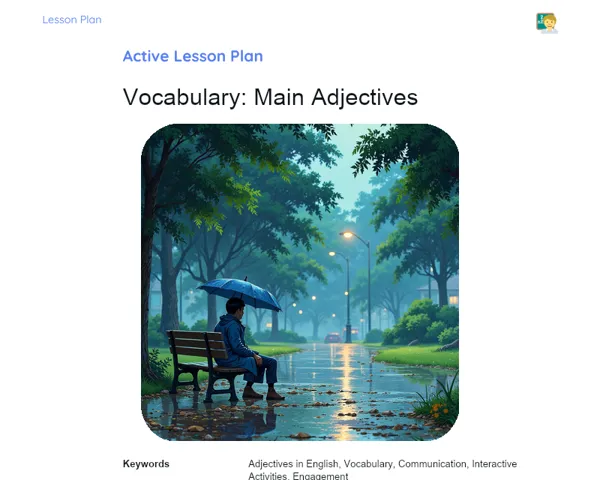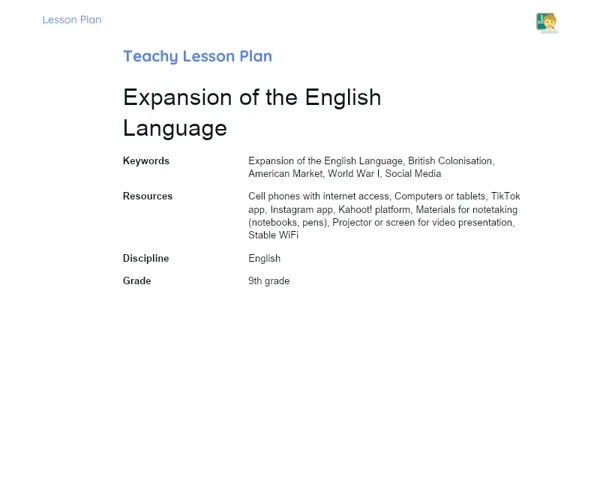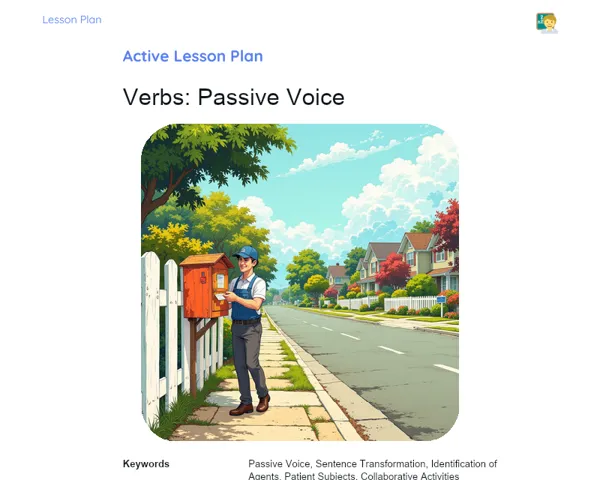Lesson Plan | Socioemotional Learning | Vocabulary: Human Body Parts
| Keywords | Vocabulary, Human Body Parts, English, Grade 9, Self-Knowledge, Self-Control, Responsible Decision-Making, Social Skills, Social Awareness, RULER, Mindfulness, Empathy, Self-Expression, Emotional Regulation |
| Resources | Sheets of paper, Pencils, Images and diagrams of the human body, Whiteboard and markers, Flashcards for vocabulary in English, Audio devices for pronunciation practice (optional) |
| Codes | - |
| Grade | 9th grade |
| Discipline | English |
Objective
Duration: 10 to 15 minutes
This stage helps clarify the lesson's objectives for students, underscoring the importance of vocabulary concerning body parts in English. Additionally, it prepares them emotionally and cognitively for learning, in line with socio-emotional methodology and the RULER approach.
Objective Utama
1. Identify and name the main body parts in English.
2. Comprehend and appropriately use vocabulary related to human body parts in English.
Introduction
Duration: 10 to 15 minutes
Emotional Warmup Activity
Mindfulness for Emotional Preparation
The Mindfulness activity is aimed at helping students stay grounded in the present moment and enhances their awareness. This practice will assist the students in concentrating and being emotionally ready for the lesson.
1. Ask the students to sit up straight in their chairs, feet flat on the floor and hands resting on their legs.
2. Instruct them to close their eyes and take three deep breaths, inhaling through the nose and exhaling through the mouth.
3. Encourage students to zero in on their breath, noticing the air flowing in and out of their bodies.
4. Guide them to acknowledge any thoughts or feelings that come up, without judgment, simply noticing them and then returning their focus to their breath.
5. Keep guiding for about 5 minutes, encouraging continuous focus on breathing and the present moment.
6. After mindfulness, ask the students to gently open their eyes and take one more deep breath before shifting back to the lesson.
Content Contextualization
Grasping the names of body parts in English goes beyond just language skills; it's about better understanding oneself and others. Knowing how to name and describe body parts is crucial in various situations, whether needing medical advice, engaging in sports, or chatting with friends. Also, being able to express the emotions tied to our bodies can improve our communication and relationships. For example, articulating pain in a specific area can help someone seek appropriate medical attention, while empathizing with others fosters collaboration.
Development
Duration: 60 to 75 minutes
Theory Guide
Duration: 20 to 25 minutes
1. Head: Comprises hair, face, eyes, ears, nose, and mouth.
2. Torso: Includes the neck, shoulders, chest, abdomen, and back.
3. Arms: Consist of arms, elbows, wrists, and hands, which have fingers and thumbs.
4. Legs: Include thighs, knees, calves, and ankles, with feet that have toes.
5. Discuss the basic functions of each body part, such as using eyes for seeing and the nose for smelling.
6. Utilize images and diagrams to aid students in visualising and understanding the terms. Show a labelled diagram of the human body.
7. Give sentence examples incorporating the vocabulary, like 'My head is sore' or 'She has beautiful hair.'
8. Make analogies for clearer understanding, like comparing the human arm to a lever that pivots at various joints (shoulder, elbow, wrist).
9. Encourage students to repeat the terms in English after you for pronunciation practice.
Activity with Socioemotional Feedback
Duration: 25 to 30 minutes
Drawing and Labeling the Human Body
In this hands-on activity, learners will sketch a human figure on paper and accurately label the body parts in English. This task reinforces the vocabulary covered while fostering self-awareness and self-expression skills.
1. Hand out sheets of paper and pencils to each student.
2. Instruct students to draw a simple human figure.
3. Guide them to label the body parts in English using the new vocabulary.
4. Allow students to add personal touches to their figures, like hair, clothing, etc.
5. Once done, invite some students to share their drawings with the class by identifying the body parts in English.
Discussion and Group Feedback
Following this activity, gather the students in a circle for a group discussion. Use the RULER method to steer the conversation. Recognize the feelings expressed during the activity by asking how they felt while drawing and labelling. Understand the reasons behind those feelings, motivating students to explore why certain emotions surfaced. Label emotions accurately, helping them identify whether they felt joy, frustration, pride, etc. Express emotions appropriately, enabling students to share their experiences and feelings respectfully and openly. Regulate emotions by discussing strategies to cope with any difficult feelings that arose, like being patient and persistent. This discussion enhances both vocabulary retention and the socio-emotional growth of students.
Conclusion
Duration: 15 to 20 minutes
Reflection and Emotional Regulation
For reflection and emotional regulation, encourage students to write a paragraph about the challenges they faced in today's lesson, focusing on their feelings as they learned and used the new vocabulary related to body parts in English. Alternatively, facilitate a group discussion for everyone to share their reflections. Ask them to think about how they managed their emotions throughout the lesson, identifying notable moments of frustration, satisfaction, or other significant feelings.
Objective: This section aims to promote self-reflection and emotional management among students. By reflecting on challenges faced and emotions experienced, they learn to identify effective strategies for navigating difficult situations. This not only bolsters their socio-emotional skills but also enhances empathy and communication capabilities.
Glimpse into the Future
To wrap things up, suggest that students set personal and academic goals connected to the lesson material. For instance, each student can choose a body part they wish to explore further or use the newfound vocabulary in a real-life conversation. Invite students to share their goals with the class, fostering a sense of commitment and teamwork.
Penetapan Objective:
1. Review and practice vocabulary related to human body parts in English daily.
2. Incorporate the vocabulary learned into sentences and everyday conversations.
3. Enhance the pronunciation of vocabulary related to body parts.
4. Develop the skill to recognise and name emotions in English associated with different body parts.
5. Encourage empathy and effective communication through understanding and expressing emotions appropriately. Objective: This section aims to boost students' autonomy and practical application of what they've learned. By setting personal and academic goals, students are motivated to continue developing their language and socio-emotional skills, nurturing ongoing growth in both educational and personal spheres.



